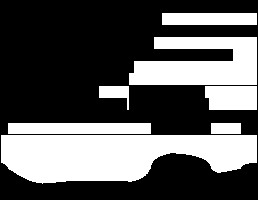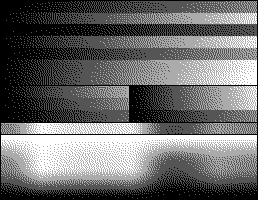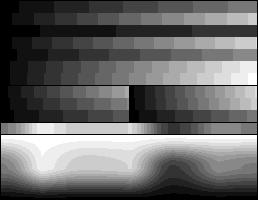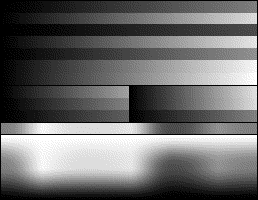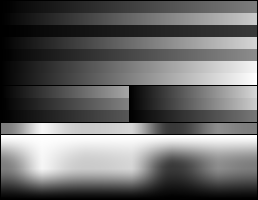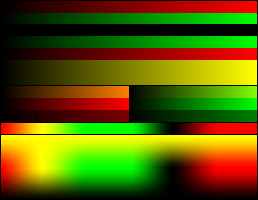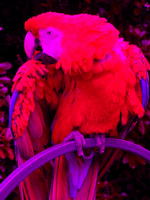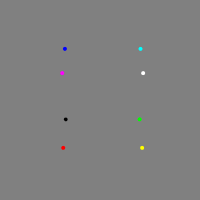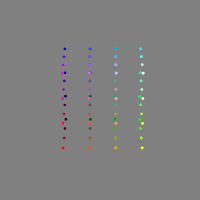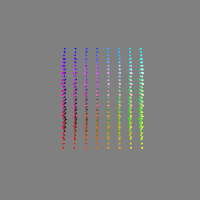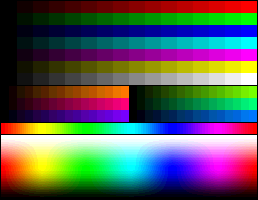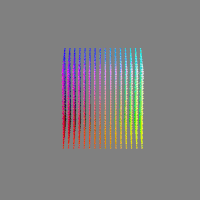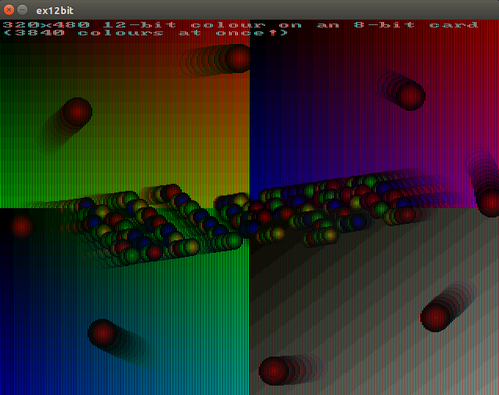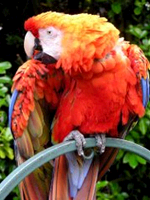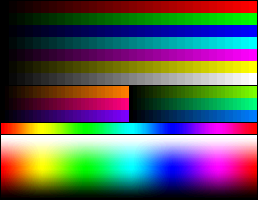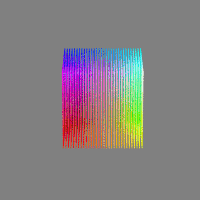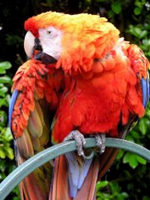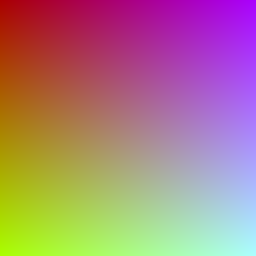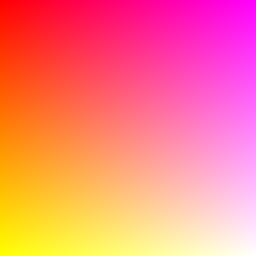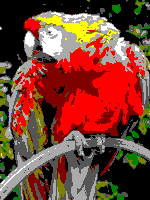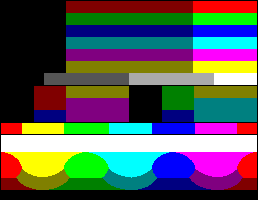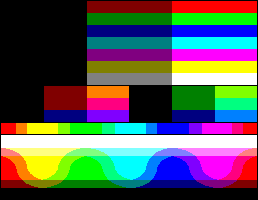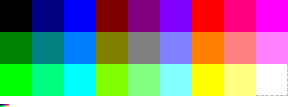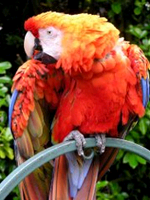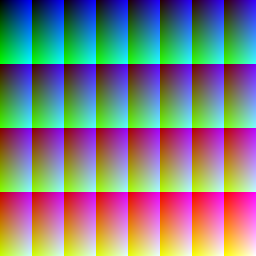
The RGB color model is an additive color model in which red, green, and blue light are added together in various ways to reproduce a broad array of colors. The name of the model comes from the initials of the three additive primary colors, red, green, and blue.

Video Graphics Array (VGA) is a graphics standard for video display controllers first introduced with the IBM PS/2 line of computers in 1987, following CGA and EGA introduced in earlier IBM personal computers. Through widespread adoption, the term has also come to mean either an analog computer display standard, the 15-pin D-subminiature VGA connector, or the 640×480 resolution characteristic of the VGA hardware.

The Hercules Graphics Card (HGC) is a computer graphics controller made by Hercules Computer Technology, Inc. that combines IBM's text-only MDA display standard with a bitmapped graphics mode. This allows the HGC to offer both high-quality text and graphics from a single card. The HGC was very popular, and became a widely supported de facto display standard on IBM PC compatibles connected to a monochrome monitor. The HGC standard was used long after more technically capable systems had entered the market, especially on dual-monitor setups.

The Enhanced Graphics Adapter (EGA) is an IBM PC computer display standard from 1984 that superseded and exceeded the capabilities of the CGA standard introduced with the original IBM PC, and was itself superseded by the VGA standard in 1987.
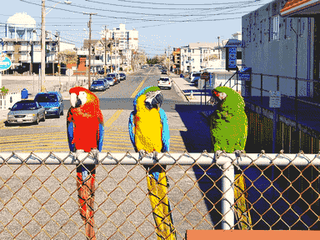
Extra Half-Brite (EHB) mode is a planar display mode of the Commodore Amiga computer. It uses six bitplanes. The first five bitplanes index 32 colors selected from a 12-bit color space. If the bit on the sixth bitplane is set the display hardware halves the brightness of the corresponding color component. This way 64 simultaneous colors are possible while only using 32 color registers. The number of color registers is a hardware limitation of pre-AGA chipsets used in Amiga computers. Some contemporary game titles and animations used EHB mode as a hardware-assisted means to display shadows or silhouettes. EHB was also often used as general-purpose 64 color mode with the aforementioned restrictions.

Mode 13h is the standard 256-color mode on VGA graphics hardware introduced in 1987 with the IBM PS/2. It has a resolution of 320×200 pixels. It was used extensively in computer games and art/animation software of the late 1980s and early to mid-1990s. "13h" refers to the number of the mode in the VGA BIOS. The "h" stands for hexadecimal; it is actually mode 19 in decimal.
A random-access memory digital-to-analog converter (RAMDAC) is a combination of three fast digital-to-analog converters (DACs) with a small static random-access memory (SRAM) used in computer graphics display controllers to store the color palette and to generate the analog signals to drive a color monitor. The logical color number from the display memory is fed into the address inputs of the SRAM to select a palette entry to appear on the data output of the SRAM. This entry is composed of three separate values corresponding to the three components of the desired physical color. Each component value is fed to a separate DAC, whose analog output goes to the monitor, and ultimately to one of its three electron guns.

The Color Graphics Adapter (CGA), originally also called the Color/Graphics Adapter or IBM Color/Graphics Monitor Adapter, introduced in 1981, was IBM's first graphics card and first color display card for the IBM PC. For this reason, it also became that computer's first color computer display standard.
The Multi-Color Graphics Array or MCGA is a video subsystem built into the motherboard of the IBM PS/2 Model 30, introduced on April 2, 1987, and Model 25, introduced later on August 11; no standalone MCGA cards were ever made.

Hold-And-Modify, usually abbreviated as HAM, is a display mode of the Commodore Amiga computer. It uses a highly unusual technique to express the color of pixels, allowing many more colors to appear on screen than would otherwise be possible. HAM mode was commonly used to display digitized photographs or video frames, bitmap art and occasionally animation. At the time of the Amiga's launch in 1985, this near-photorealistic display was unprecedented for a home computer and it was widely used to demonstrate the Amiga's graphical capability. However, HAM has significant technical limitations which prevent it from being used as a general purpose display mode.

Professional Graphics Controller is a graphics card manufactured by IBM for PCs. It consists of three interconnected PCBs, and contains its own processor and memory. The PGC was, at the time of its release, the most advanced graphics card for the IBM XT and aimed for tasks such as CAD.
In computing, indexed color is a technique to manage digital images' colors in a limited fashion, in order to save computer memory and file storage, while speeding up display refresh and file transfers. It is a form of vector quantization compression.

VGA text mode was introduced in 1987 by IBM as part of the VGA standard for its IBM PS/2 computers. Its use on IBM PC compatibles was widespread through the 1990s and persists today for some applications on modern computers. The main features of VGA text mode are colored characters and their background, blinking, various shapes of the cursor, and loadable fonts. The Linux console traditionally uses hardware VGA text modes, and the Win32 console environment has an ability to switch the screen to text mode for some text window sizes.

Tandy Graphics Adapter is a computer display standard for an IBM PC compatible video subsystem that improved on IBM's Color Graphics Adapter (CGA) technology. Whereas CGA could display only four colors at a time at a screen resolution of 320×200 pixels, a TGA system could display up to 16 colors. While not strictly an adapter—the TGA hardware was available only integrated onto computer motherboards, not on a separate card—TGA is so called to parallel CGA, to which TGA is related and with which it competed.

Composite artifact colors is a designation commonly used to address several graphic modes of some 1970s and 1980s home computers. With some machines, when connected to an NTSC TV or monitor over composite video outputs, the video signal encoding allowed for extra colors to be displayed, by manipulating the pixel position on screen, not being limited by each machine's hardware color palette.



